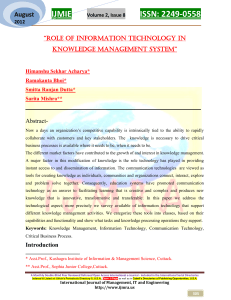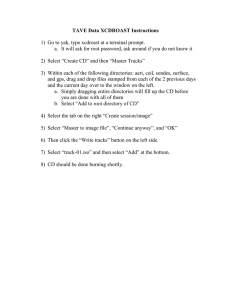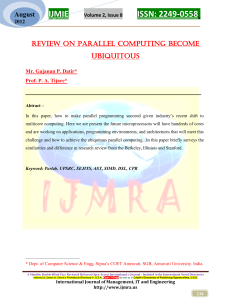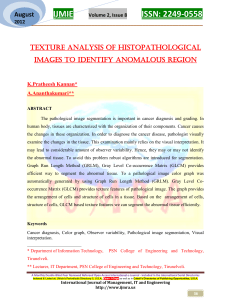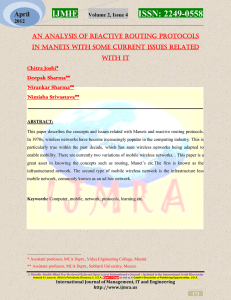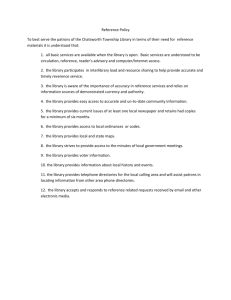IJMRA-MIE1545
advertisement
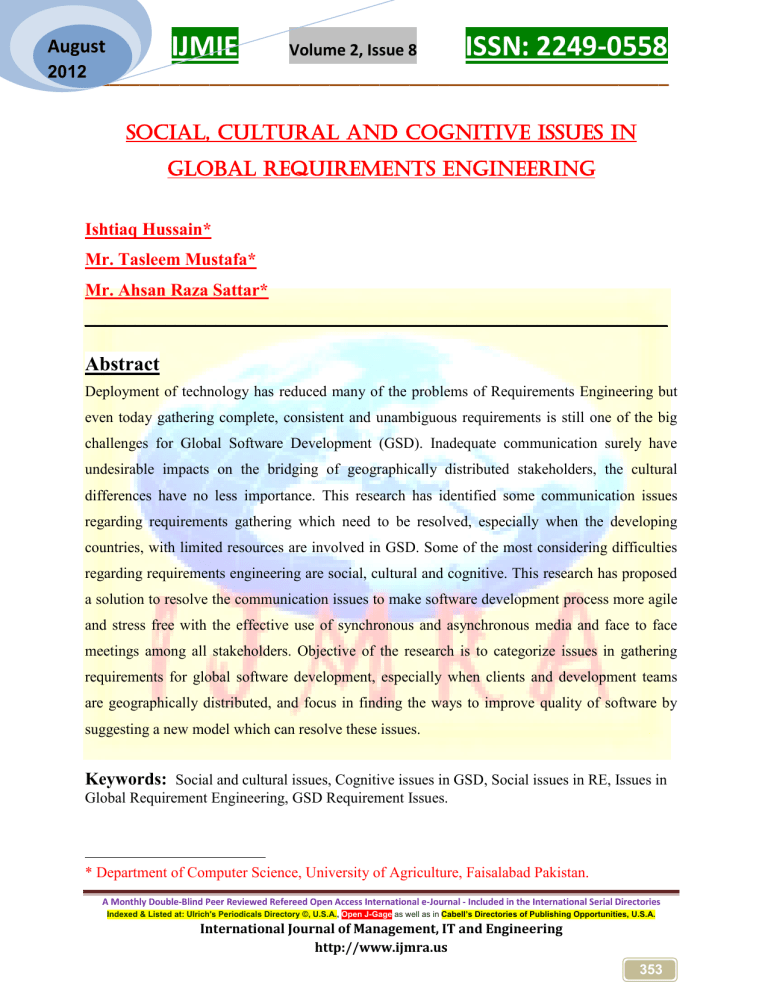
August IJMIE Volume 2, Issue 8 ISSN: 2249-0558 2012___________________________________________________________ Social, Cultural and Cognitive Issues in Global Requirements Engineering Ishtiaq Hussain* Mr. Tasleem Mustafa* Mr. Ahsan Raza Sattar* __________________________________________________________ Abstract Deployment of technology has reduced many of the problems of Requirements Engineering but even today gathering complete, consistent and unambiguous requirements is still one of the big challenges for Global Software Development (GSD). Inadequate communication surely have undesirable impacts on the bridging of geographically distributed stakeholders, the cultural differences have no less importance. This research has identified some communication issues regarding requirements gathering which need to be resolved, especially when the developing countries, with limited resources are involved in GSD. Some of the most considering difficulties regarding requirements engineering are social, cultural and cognitive. This research has proposed a solution to resolve the communication issues to make software development process more agile and stress free with the effective use of synchronous and asynchronous media and face to face meetings among all stakeholders. Objective of the research is to categorize issues in gathering requirements for global software development, especially when clients and development teams are geographically distributed, and focus in finding the ways to improve quality of software by suggesting a new model which can resolve these issues. Keywords: Social and cultural issues, Cognitive issues in GSD, Social issues in RE, Issues in Global Requirement Engineering, GSD Requirement Issues. * Department of Computer Science, University of Agriculture, Faisalabad Pakistan. A Monthly Double-Blind Peer Reviewed Refereed Open Access International e-Journal - Included in the International Serial Directories Indexed & Listed at: Ulrich's Periodicals Directory ©, U.S.A., Open J-Gage as well as in Cabell’s Directories of Publishing Opportunities, U.S.A. International Journal of Management, IT and Engineering http://www.ijmra.us 353 August IJMIE Volume 2, Issue 8 ISSN: 2249-0558 2012___________________________________________________________ 1. Introduction Organizations keep on growing worldwide, by expanding the business and teams across the globe using all possible ways like outsourcing [14], offshoring and partnering. As communication among stakeholders increases the software starts evolving from an idea to a full-fledged system. All the required features are discussed and documented in the form of Software Requirement Specification (SRS) which becomes the starting point for the development team. Software requirements keep on evolving and changing over and over again, this makes it hard to manage and trace the requirements’ related tasks. It becomes more challenging when the stakeholders are geographically on different sites.[6] The ultimate aim of GSD is to reduce cost and utilize the best available resources with diversity of knowledge and skills. In this research we have discussed a software development model for the developing countries which are involved in exporting IT products and services to the developed countries[8]. Here Pakistan is taken as a developing country that has been exporting software and providing services to the most advanced countries of the world like USA, UK, Canada and Japan. The idea of globally distributed software development is the best way to gain momentum in economic terms. Besides bringing this great opportunity of business and exposure to the world, global software development introduces some issues, that if resolved the developing countries may experience a revolution in IT exports. This research has examined the existing requirements engineering process practiced in Pakistan [14]. The purpose is to develop further understanding of the process of requirements gathering in global software development context. Firstly we have discussed some overall global requirements issues and after that issues faced by Pakistan software industry have been explained, at the end a solution has been proposed that has the resolution of all the issues discussed in this research. 2. Issues in Gathering Requirements Globally Although global Software development promises great opportunities of business and trade all around the world but it also has some social, cultural and cognitive context as well, which certainly have severe impacts on the development of the software system. Following are some common issues in global software development A Monthly Double-Blind Peer Reviewed Refereed Open Access International e-Journal - Included in the International Serial Directories Indexed & Listed at: Ulrich's Periodicals Directory ©, U.S.A., Open J-Gage as well as in Cabell’s Directories of Publishing Opportunities, U.S.A. International Journal of Management, IT and Engineering http://www.ijmra.us 354 August IJMIE Volume 2, Issue 8 ISSN: 2249-0558 2012___________________________________________________________ 2.1 Social Issues The major groups involved in software development are the customer, the RE team and the development team [15]. The first issue is the identification of the real system users who may not know what to expect from the system. Generally in an organization there are people who have been assigned the duty to communicate with the requirement team. These issues arose less where the end users are at liberty to communicate with the requirement engineering team in particular and development team in general[1]. The requirement team may have certain issues within itself as they are also a social entity whereas other social issues are among RE team, development team and the customer. 2.2 Cultural Issues Culture can help us to understand the information hidden behind the words said by any person, Language Language is the first step for the effective communication. In the perspective of global software development it is really important to know the context of the requirements provided by the client. Because of language differences, the client [9] cannot sufficiently convey what he wants and the analysts are unable to perceive and understand the needs of the client. This results in ambiguous and incomplete requirements for development team. Ethics In our social life everything that we come across is an inherent ethical component. When the important data is provided to the requirement team of a software development company the level of trust should not be breached at any cost [13][6]. Requirements engineers occasionally are in situations when some traits of their work are considered to be concealed from various stakeholders. When the contract is signed its generally of great concern that to what extent the development company should be given information about the business as there is always the hesitation that market competitors must not get that information at all. On other side the persons providing most of the information about the legacy system may be no longer in employment, as the new system may need some special skills or smaller number of employees. A Monthly Double-Blind Peer Reviewed Refereed Open Access International e-Journal - Included in the International Serial Directories Indexed & Listed at: Ulrich's Periodicals Directory ©, U.S.A., Open J-Gage as well as in Cabell’s Directories of Publishing Opportunities, U.S.A. International Journal of Management, IT and Engineering http://www.ijmra.us 355 August IJMIE Volume 2, Issue 8 ISSN: 2249-0558 2012___________________________________________________________ 2.3 Cognitive Issues Issues related to the understanding of a certain thing from one’s own point of view falls under the cognitive issues of human behavior Problem of Tacit Knowledge The people do certain things in their routine but it becomes really hard for them to explain how they do it, but it is very easy for them to show us how to do it. In social sciences, we call it the say-do[4] issues. Requirement engineers have to obtain the requirements from the words and action of the clients and end users; these are the issue of tacit knowledge. It is significant to build the system that meets the real business needs of the client and conforms the purpose for which the system was developed. That is why special techniques are required to extract the tacit knowledge hidden behind the words and actions. Cognitive Aspects of RE Cognitive aspect in requirement engineering helps the development team to understand the stakeholders’ difficulty in explaining their needs. The domain specialists are so experienced that they can unknowingly overlook the most important part of that process [10]. It becomes a problem for requirements engineers to get the most relevant information that truly depicts the system to be developed. So the Requirement engineers prepare models to make sure that they understood exactly the same as was described later these models are provided to the development team for software development[3]. Human Behavior Human behavior is the most unexpected and complex activity that can take place in different ways, it varies from person to person. In different circumstances same person can behave differently. In the context of requirements engineering this variation causes certain issues in requirements elicitation and modeling phase [5]. Missing, incomplete and inconsistent requirements which analysts fail to comprehend are serious threats and risks to the final system to be delivered. Expert cognitive scientists or human behaviorists can help RE practitioners to understand their varying behaviors. Human Factors Human factors are concerned with human errors i.e., errors or mistakes committed by human beings while involved in the RE process, resulting in erroneous systems. Research on human error A Monthly Double-Blind Peer Reviewed Refereed Open Access International e-Journal - Included in the International Serial Directories Indexed & Listed at: Ulrich's Periodicals Directory ©, U.S.A., Open J-Gage as well as in Cabell’s Directories of Publishing Opportunities, U.S.A. International Journal of Management, IT and Engineering http://www.ijmra.us 356 August IJMIE Volume 2, Issue 8 ISSN: 2249-0558 2012___________________________________________________________ has typically focused on the work of individuals from a cognitive perspective. Human errors are causes of: Errors in the work of an individual Violations of the predefined rules Group process losses These are the factors which must be considered while making any type of systems, especially intelligent and healthcare systems [4]. 3. Research Methodology A survey has been conducted to collect data about the issues that are faced by requirement engineering practitioners in Pakistan. Primary emphasis of the survey is to identify the social, cultural and cognitive issues so that the areas needing further improvement can be highlighted and appropriate requirement engineering practices can be recommended to help the requirement engineering practitioners. The survey was conducted in 22 local software development organizations, involved in diverse commercial applications. The survey report shows that in global projects the requirements gathering is performed through face to face meetings and through other media. Local organizations generally face challenges, when geographically distributed stakeholders sitting in different time zones, with cross-functional teams explaining requirements for the system to be developed, each team provides its own view of the system. The report also exhibits that requirement gathering process is badly affected by the poor communication. 3.1 RE Issues in Local Industry Requirement gathering methodologies in the local industry have improved over time. Instead of an informal process, it is now become the part of the software development life-cycle and software organizations are investing more resources and time on it [15]. Like other parts of the world requirement engineering practitioners of the local software industry have also experienced social, cultural, political and cognitive issues during Requirement Engineering process because majority of the clients are distributed around the world. A Monthly Double-Blind Peer Reviewed Refereed Open Access International e-Journal - Included in the International Serial Directories Indexed & Listed at: Ulrich's Periodicals Directory ©, U.S.A., Open J-Gage as well as in Cabell’s Directories of Publishing Opportunities, U.S.A. International Journal of Management, IT and Engineering http://www.ijmra.us 357 August IJMIE Volume 2, Issue 8 ISSN: 2249-0558 2012___________________________________________________________ The difference between local and global software development is that the global software development has very fragile bonds which are largely affected by the misinterpretations and hesitancy to freely speak up to other stakeholders. 3.2 Survey Results The analysis of the local industry indicates that most of the requirement engineering issues in the local industry are due poor communication, from both ends. Almost 50% of the software organizations have their representatives at the client end, who interact with the client and then communicate the client requirements to the offshore team. For some local software organization, this is a useful technique; provided the offshore representative has technical as well as managerial knowledge to effectively [10] communicate and interact with the client. For organizations not having technical representatives at the offshore end, gathering and understanding client requirements becomes a fairly difficult task due to communication issues [12]. In very few organizations the client representatives visit the software development organizations, to have formal meetings. This however does facilitate the better requirements negotiation because of the presence of all the concerned departments in the discussion. Communication with the clients is normally done through emails (40%), chat conferencing (20%) or phones (15%). A limited number of face to face meetings (10%) are held with the client. However, in only a few local companies (5%), video conferencing is used. The people using this mode communication believe that it has effectively improved their interaction with the client, as it facilitates a kind of virtual environment in which both the client and analyst participants can view each other and contribute in some form of natural discussion. Some internal issues are faced The power distance is a big problem which creates barriers among the junior, senior developer and the Project Manager. The client is usually in contact with the Project Manager, so each and every requirement is well understood by the Project Manager, but due to power distance the junior developer is[14] unable to understand and is hesitant to ask a simple question or give any type of suggestion Lack of trust is also an issue in small companies other than the power distance, because it is suspected that direct communication between the client and the developer may snatch A Monthly Double-Blind Peer Reviewed Refereed Open Access International e-Journal - Included in the International Serial Directories Indexed & Listed at: Ulrich's Periodicals Directory ©, U.S.A., Open J-Gage as well as in Cabell’s Directories of Publishing Opportunities, U.S.A. International Journal of Management, IT and Engineering http://www.ijmra.us 358 August IJMIE Volume 2, Issue 8 ISSN: 2249-0558 2012___________________________________________________________ the client from the company and the developer can make a deal privately with the client who is generally in search of discounted development cost. There is substantial loss of information when after the online meetings with the clients project managers describe new requirements and changes to the developers [7]. As the meeting is so formal that the rationale behind the new requirement or requirement change is not considered important to discuss with the development team, this is one of the reasons of uncertainty in the requirements, later on when requirements are analyzed, these are found to be conflicting with the existing requirements as a result the unwanted functionality is added to the software and a lot of rework is done Mostly the teams are engaged in more than two projects at the same time, when a team is analyzing and doing research on one project they are asked to immediately switch to the other project and leave the current so most of the work and planning done so far is wasted Mostly the time estimation for intelligent applications is not accurate. Developers have to work under pressure, that results in rework and over scheduled deliverable Requirements are changed so frequently that it becomes very difficult to manage and document them Although most of the clients of the local software organizations are distributed worldwide, they experience plentiful cultural problems which exacerbate the live interaction, discussion and meetings with the clients[3]. Since much of the requirement engineering work gets done through phone calls, emails and sometimes through videoconferencing. The time difference between the developer and the client organization is troublesome for the requirement engineering practitioners, as a result effective communication rarely takes place and less number of team member’s show up for the conference calls. However, as reported by some of the survey targets, this time difference gives the development side an added advantage when the deadlines are near, because they get extra time for the delivery of the artifacts or milestone. Conflicts arise in requirement engineering team while eliciting and analyzing requirements. There could be a number of factors causing social conflicts, which sinks the morale of the team and act as one of the major causes of requirements eliciting inadequate requirements. Furthermore, many projects [11] managers have reported that a large number of requirement change are initiated by the client throughout the system development life cycle, even during the A Monthly Double-Blind Peer Reviewed Refereed Open Access International e-Journal - Included in the International Serial Directories Indexed & Listed at: Ulrich's Periodicals Directory ©, U.S.A., Open J-Gage as well as in Cabell’s Directories of Publishing Opportunities, U.S.A. International Journal of Management, IT and Engineering http://www.ijmra.us 359 August IJMIE Volume 2, Issue 8 ISSN: 2249-0558 2012___________________________________________________________ development and testing phases. This is due to inadequate interaction with the client leading to inadequate requirements elicitation in the requirement phase. The only requirement elicitation methodologies in practice are conversation on the phone, emails and meetings with the client conducted by the analyst representatives. Requirement elicitation techniques like Ethnomethodology, focus groups, protocol analysis, conversation analysis and interaction are not practiced at all. Furthermore, there are no means used by local industry to address [6] the cognitive problems faced by the requirement engineers while eliciting and analyzing requirements. Certainly it is needed to make sure that the requirements must be explained with their background which must be digested in the requirement document, it will make requirement negotiation and traceability easier and simpler. So it is proposed that there is a certain need for requirement engineering process improvement so that this basic and important activity could be performed with full attention and collaboration with the client and the development team 4. Proposed Solution A great deal of research has been made so far in the field of requirement engineering but the social, cultural and cognitive factors were explored to the lesser extent in global software development, it is much needed to find a perfect solution for these issues[2]. If the requirements are complete, consistent, clear and well written then the software development is not a big issue. Here comes the need to learn client’s language and his national culture to know the real perspective of the customer wants and needs [8]. Other than resolving many of the social, cultural and cognitive issues, our proposed solution can help developing countries in increasing IT exports to the developed countries. During the survey a question was posed to the software development companies that “what will be the response from your company if the number of projects is increased up to 50% or 100%?” The most common answer was that they can increase the number of resource but will not miss any project. So there is a proposition of the evolution of Requirements Engineering Software Houses that will perform Requirement Engineering and SQA activities. RESH will be in contact with local software development companies [12]. These software houses will have qualified Requirement Engineers capable to speak and understand at least one foreign language other than A Monthly Double-Blind Peer Reviewed Refereed Open Access International e-Journal - Included in the International Serial Directories Indexed & Listed at: Ulrich's Periodicals Directory ©, U.S.A., Open J-Gage as well as in Cabell’s Directories of Publishing Opportunities, U.S.A. International Journal of Management, IT and Engineering http://www.ijmra.us 360 August IJMIE Volume 2, Issue 8 ISSN: 2249-0558 2012___________________________________________________________ English. For each foreign language there would be a Requirement team which will be sent to the relevant regions for market research and to know about their social, cultural norms and to attend seminars, symposiums, conferences, meetings and conventions. This team will be responsible for all phases of requirement gathering from their associated countries. These RESHs (Requirements Engineering Software Houses) must have a separate SQA [14] team to make sure that requirements are free from any sort errors and are well written verifying with the help of reviews and inspections. The Software Requirement Specification (SRS) will be written in two languages [1], the client language and the development team language. Later on after the development is complete the SQA team of RESH will perform conformance and user acceptance testing and software will be delivered to the client The basic purpose is to increase software exports to the developing countries by utilizing the Requirement Engineering techniques. There is great difference between developing software in the global perspective and developing software in co-located area because of the distance, trust factor, time zone differences, language differences, misunderstandings and reluctance to talks to the client and many other problems which may evolve in this kind of contractual relationship. However it has been never stress-free to gather consistent and complete requirements even in the local environment but it becomes even harder to get high quality requirements in GSD because of the issues. On one side RESH can utilize the pool of resource properly, on the other side client will get the quality products verified by the RESH SQA team and help in building trust [12] of the client. 5. Conclusion This research presents a detailed literature on the social, cultural and cognitive issues of requirement engineering. The research has revealed that ethnomethodology is a useful and effective technique that promises to address the problems of tacit knowledge while gathering and eliciting requirements [6]. The analysis disclosed that requirement engineering issues are in the local industry is no different than the other parts of the world. Most of the clients are geographically distributed giving rise to intense cultural and social problems [5]. There are no proper methodologies in practice to address these issues. A Monthly Double-Blind Peer Reviewed Refereed Open Access International e-Journal - Included in the International Serial Directories Indexed & Listed at: Ulrich's Periodicals Directory ©, U.S.A., Open J-Gage as well as in Cabell’s Directories of Publishing Opportunities, U.S.A. International Journal of Management, IT and Engineering http://www.ijmra.us 361 August IJMIE Volume 2, Issue 8 ISSN: 2249-0558 2012___________________________________________________________ The research concludes that there is a certain need to introduce the virtual locale and ethnomethodology in the most initial form, so that requirement engineering process could be improved and made more productive. Misinterpretation [12] has been found a common source of problems so it is concluded that the informal communication is necessary to develop and maintain respect and trust among all stakeholders. The software industry can achieve more economic gains in terms of development productivity and product quality if the requirement engineering techniques are adopted in a systematic way. It is evident that social, cultural and cognitive factors certainly have an impact on the software cost, quality and development. If requirements are well understood the software can be delivered in time and within budget, because a well written and comprehensive requirement document provides the starting point to the development team. References [1] A.Wassyng, and X. Hu. Timing tolerances in safety-critical software. In Proceedings. of the Int. System. of Form. Meth. Eur., pages 157–172, 2005 [2] Damian, D. and Zowghi, D. “An insight into the interplay between culture, conflict and distance in globally distributed requirements negotiations. Proceedings of the 36th Hawaii International Conference on System Sciences (HICSS’03) 2002 IEEE [3] Escalona, M. and Koch, N.” Metamodeling the Requirements of Web Systems". In WEBIST 2006- The Second International Conference for Web Information Systems and Technologies, Setubal, Portugal 2006 [4] Garde. S., Knaup. P, “Requirements engineering in health care: the example of chemotherapy planning in paediatric oncology,” Requirements engineering, vol. 11, no. 4, pp. 265–278, 2006 [5] Herbsleb, J., et al. R.E. An empirical study of global software development: distance and speed, International Conference. on Software Engineering, Toronto, 2001 [6] K. S. Wasson. A case study in systematic improvement of language for requirements. In Proceeding. of the IEEE Int. Requirement. Engineering. Conference, pages 6–15, 2006 [7] M. Sabetzadeh, S. Easterbrook. View merging in the presence of incompleteness and inconsistency. Requirement. Engineering. Journal, 11(3):174–193, 2006 A Monthly Double-Blind Peer Reviewed Refereed Open Access International e-Journal - Included in the International Serial Directories Indexed & Listed at: Ulrich's Periodicals Directory ©, U.S.A., Open J-Gage as well as in Cabell’s Directories of Publishing Opportunities, U.S.A. International Journal of Management, IT and Engineering http://www.ijmra.us 362 August IJMIE Volume 2, Issue 8 ISSN: 2249-0558 2012___________________________________________________________ [8] Manoj Kumar, Anjana Gosain and Yogesh Singh. “Agent Oriented Requirements Engineering for a Data Warehouse” ACM SIGSOFT Software Eng Notes Volume 34 Number 5. Pp.1-4, 2009 [9] Niazi, M., et al. A framework for assisting the design of effective software process improvement implementation strategies. Journal of Systems and Software, 78, 204222, 2005 [10] Nuseibeh, B., Easterbrook, S.M.: Requirements Engineering: A Roadmap. In: The Future of Software Engineering (2000) [11] O. Benediktsson, and H. Thorbergsson,“Comparison of Software Development Life Cycles: A Multiproject Experiment,” IEE Proc – Software, vol 153, 2006, pp. 87-101 [12] Oza, N.,et al. Trust in Software Outsourcing Relationships: An Empirical Investigation of Indian Software Companies. 9th International conference. on Empirical Assessment in Software Engineering, UK. 2005 [13] Prakash, N and Gosain, A. “An approach to engineering the requirements of data warehouses”. In Springer-Veralag, Requirements Eng. Journal, 2007. [14] Shyam R. et al. Managerial Use of Metrics for Object-Oriented Software: An Exploratory Analysis. IEEE Transactions On Software Eng, Vol. 24, No. 8, Pp. 629639, 1998 [15] Sommerville, I., Ransom J.: An empirical study of industrial requirements engineering process assessment and improvement. ACM TOSEM, Vol. 14, No. 1, pp 85-117, 2005 A Monthly Double-Blind Peer Reviewed Refereed Open Access International e-Journal - Included in the International Serial Directories Indexed & Listed at: Ulrich's Periodicals Directory ©, U.S.A., Open J-Gage as well as in Cabell’s Directories of Publishing Opportunities, U.S.A. International Journal of Management, IT and Engineering http://www.ijmra.us 363
